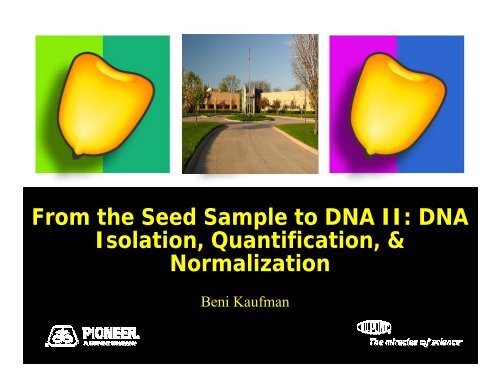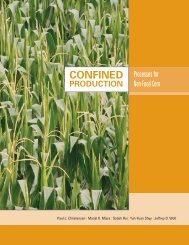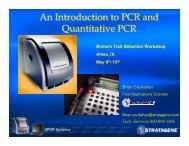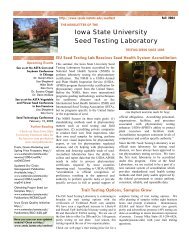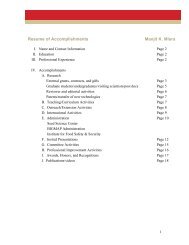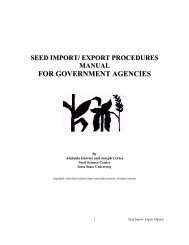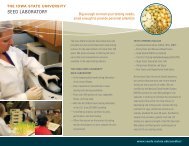The Importance of DNA Isolation
The Importance of DNA Isolation
The Importance of DNA Isolation
You also want an ePaper? Increase the reach of your titles
YUMPU automatically turns print PDFs into web optimized ePapers that Google loves.
From the Seed Sample to <strong>DNA</strong> II: <strong>DNA</strong><br />
<strong>Isolation</strong>, Quantification, &<br />
Normalization<br />
Beni Kaufman
<strong>The</strong> <strong>Importance</strong> <strong>of</strong> <strong>DNA</strong> <strong>Isolation</strong>:<br />
Quality <strong>of</strong> <strong>DNA</strong> determines PCR efficiency, hence,<br />
the detectability & sensitivity <strong>of</strong> the test.<br />
PCR efficiency is<br />
affected by the:<br />
concentration <strong>of</strong><br />
impurities:<br />
• Directly; enzyme<br />
inhibitors, or<br />
• Indirectly –<br />
– impurities<br />
binding the <strong>DNA</strong><br />
and effectively<br />
making it<br />
unavailable to<br />
the enzymatic<br />
reaction<br />
PCR<br />
PCR<br />
Set-up<br />
Normalization<br />
Quantification<br />
<strong>DNA</strong> <strong>Isolation</strong>
Also, PCR efficiency is affected by:<br />
• the integrity <strong>of</strong> <strong>DNA</strong> molecules<br />
(length <strong>of</strong> fragments, shredding,<br />
degradation)<br />
• Both impurities and degradation may<br />
affect quantification – throw <strong>of</strong>f<br />
reaction<br />
• <strong>DNA</strong> Quantity defines<br />
representation, and the<br />
contribution to sampling error<br />
THE OVERALL<br />
TESTING SUCCESS<br />
DEPENDS ON <strong>DNA</strong> ISOLATION
Challenges to isolate <strong>DNA</strong><br />
from seed:<br />
– Compared to leaf tissue: Seed<br />
contains much less <strong>DNA</strong> and much<br />
(much) more “impurities”<br />
(carbohydrates, phenols, lipids)<br />
– <strong>The</strong> most labor intensive step<br />
– <strong>The</strong> priciest step<br />
– Throughput bottle neck
Isolating <strong>DNA</strong>…<br />
Grinding:<br />
mechanical breakdown<br />
<strong>of</strong> the cell wall<br />
Dissolving membranes<br />
Pulling out <strong>DNA</strong>,<br />
or impurities<br />
Cleaning…
Grinding<br />
<strong>The</strong>re is no “<strong>of</strong>f the shelf”<br />
grinder suitable for AP<br />
testing…
Grinding<br />
• Effects <strong>of</strong> particle size –<br />
…<strong>The</strong> smaller the better! ☺<br />
– <strong>The</strong> smaller the particle size, the<br />
larger the surface area and the<br />
exposure to the extraction buffer<br />
– and therefore, the more<br />
efficient the extraction…<br />
– Representation <strong>of</strong> the lot<br />
(particles per unit mass)<br />
– Homogeneity <strong>of</strong> the mixture<br />
(particles per unit volume)
Dissolving Membranes<br />
• Lysis by way <strong>of</strong>:<br />
– Detergents<br />
• SDS<br />
• CTAB<br />
– Chaotropic Salts<br />
– Alkaline Lysis<br />
– Other denaturing reagents<br />
Results in a “soup” <strong>of</strong> cellular debris<br />
and the content <strong>of</strong> the cytoplasm.
Pulling Out… Pulling In…<br />
Separate the soluble (<strong>DNA</strong>) from<br />
the insoluble (cell debris) by<br />
way <strong>of</strong>:<br />
– Centrifugation<br />
– Filtration<br />
Purify <strong>DNA</strong> from other solubles<br />
– Organic solvents<br />
– Columns<br />
– Magnetic clearing
Organic Extraction<br />
• Phenol/Chlor<strong>of</strong>orm<br />
– denatures and extracts proteins<br />
• Ethanol/high salt<br />
– Differential precipitation <strong>of</strong> <strong>DNA</strong><br />
Lengthy<br />
Labor intensive<br />
Automation hostile<br />
Safety Issues
• Silica Column<br />
Columns<br />
– <strong>DNA</strong> binds silica in high<br />
concentrations <strong>of</strong> chaotropic salts<br />
– Impurities are washed <strong>of</strong>f<br />
– Eluted <strong>of</strong>f with low ionic strength<br />
solution<br />
– Increased throughput & purity<br />
– Commercial kits<br />
NucleoSpin, DNeasy, GenElute
Magnetic Clearing<br />
• Coated paramagnetic beads<br />
– Silica<br />
– proprietary<br />
– Increased binding<br />
kinetics/efficiency<br />
– Enhanced removal <strong>of</strong><br />
contaminants<br />
– Commercially available<br />
ChargeSwitch, Wizard, MagAttract
Cleaning and Elution<br />
• Alcohol wash to remove salts<br />
and other impurities.<br />
• Elute or dissolve <strong>DNA</strong> in TE,<br />
water, or other low ionic<br />
strength buffer.<br />
Ready for quantification…
Quantification<br />
• Spectrophotometer<br />
– Absorbance at 260 nm<br />
• (UV illuminator)<br />
• Fluorometer<br />
– Hoechst Dye<br />
– PicoGreen
Spectrophotometry<br />
• Concentration = OD 260 * 50 µg/ml<br />
(ds<strong>DNA</strong>) * dilution factor<br />
• Purity<br />
– Measure <strong>of</strong> proteins<br />
OD 260 :OD 280 = 1.8<br />
– Measure <strong>of</strong> phenolics/chaotropic salts<br />
OD 260 :OD 230 > 1.5<br />
– Measure <strong>of</strong> particulates<br />
OD 330<br />
• Simple & non-destructive,<br />
• Narrow range 5 µg/ml to 90 µg/ml,<br />
easy to over estimate due to<br />
contaminates (RNA, ss<strong>DNA</strong>,<br />
nucleotides, phenols, proteins)
Fluorometry<br />
• Detection <strong>of</strong> enhanced<br />
fluorescence upon dye binding<br />
ds<strong>DNA</strong><br />
• Hoechst 33258<br />
– Quantitate to 10ng/ml<br />
• PicoGreen<br />
– Quantitate to 25pg/ml, and less<br />
sensitive to the presence <strong>of</strong><br />
contaminants (RNA, proteins,<br />
detergents)
Input raw fluorescence<br />
values for standards.
Scroll down for the<br />
standard curve.<br />
Input standard curve<br />
information.
Input raw fluorescence<br />
values for unknowns.<br />
Concentrations given<br />
here.
Normalization<br />
• Provides uniformity in testing:<br />
– To comply with the sampling scheme<br />
– To comply with validated<br />
process/assays<br />
• qPCR enables in-assay normalization<br />
but logistically simple to follow<br />
uniform processing<br />
• Enhances robustness <strong>of</strong> testing –<br />
higher success rate, hence, in the<br />
long run reduces cost, and on the<br />
average may improve turn around<br />
time
Volume Initial, Concentration Final,<br />
Concentration Initial<br />
Diluent needed to add to<br />
Volume Initial to give<br />
Concentration Final.
Throughput/Automation<br />
• At isolation, quantification, and<br />
normalization


